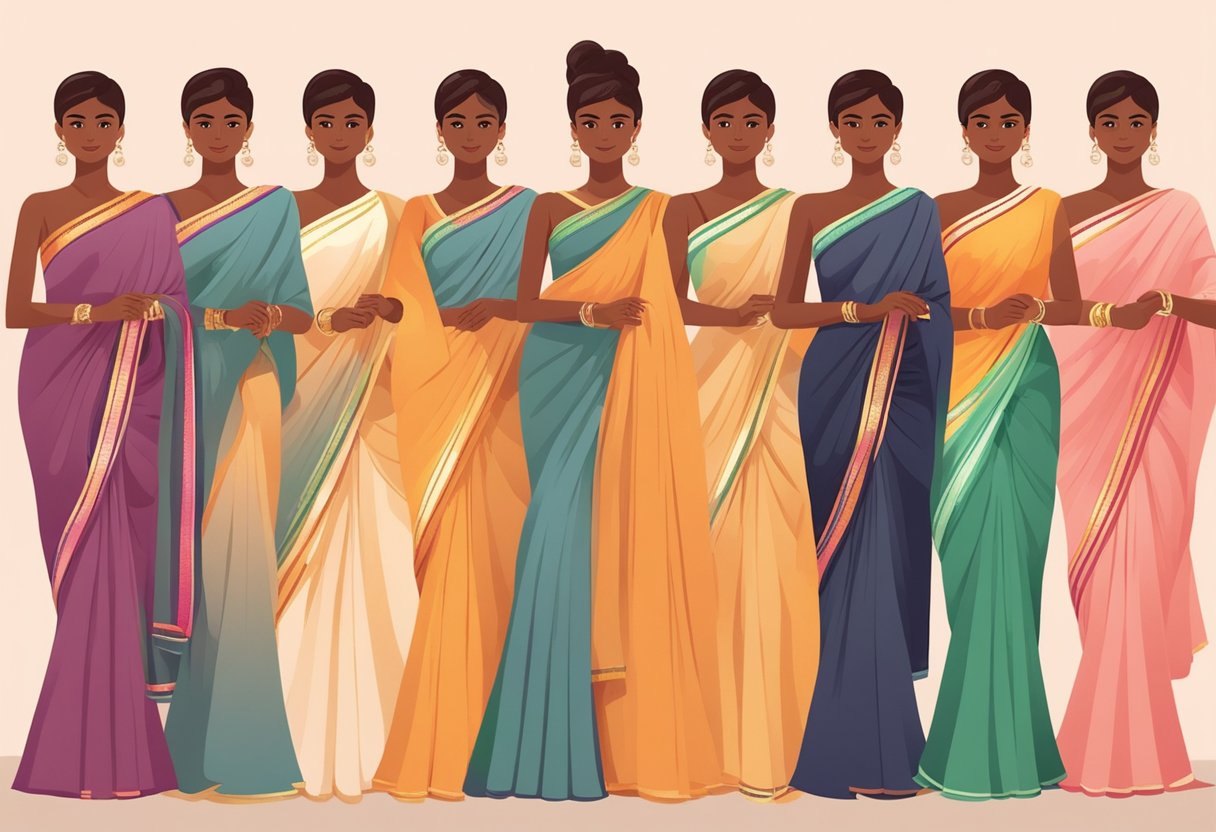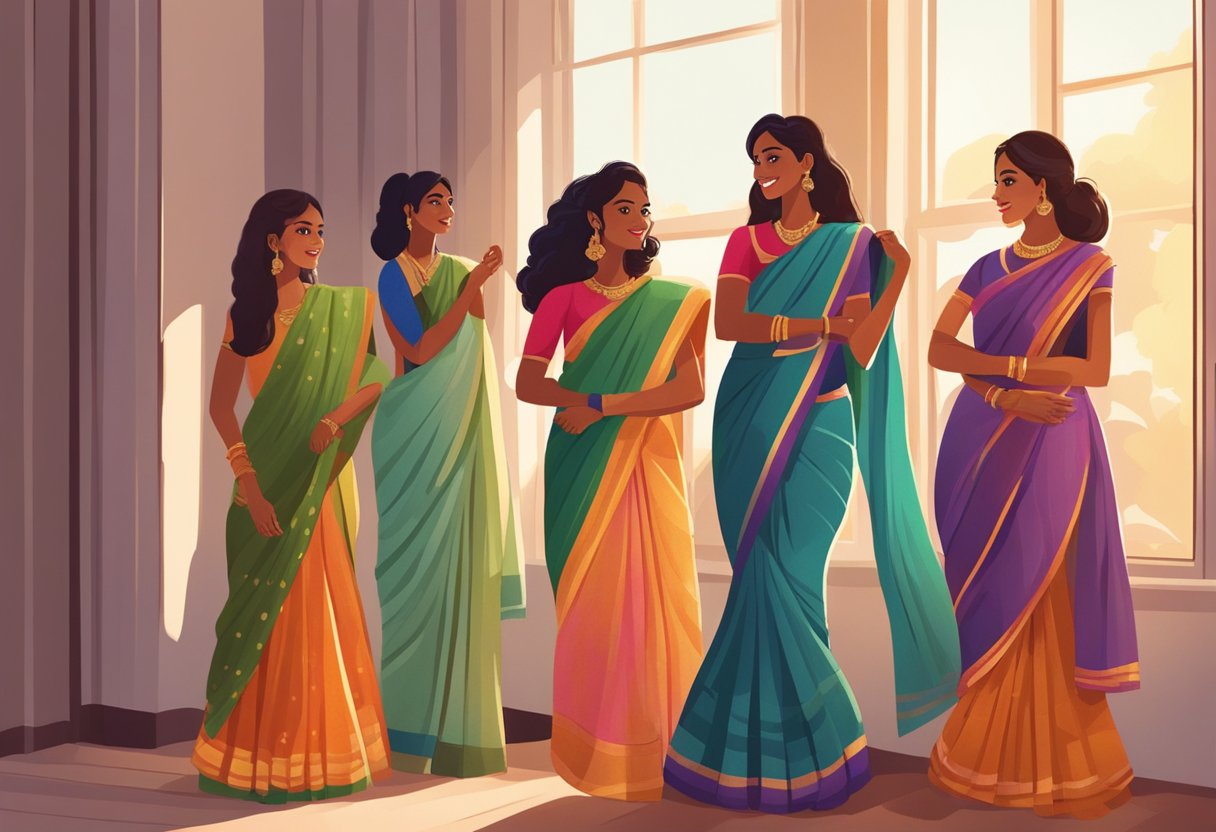Selecting the ideal saree hue based on skin tone can elevate one's appearance and create a standout effect. The array of colors available can be daunting, but with a few helpful guidelines, selecting the perfect saree shade to enhance your complexion is achievable.

The first tip is to identify your skin tone. Skin tones can be broadly categorized as warm, cool, or neutral. Warm skin tones have yellow or golden undertones, cool skin tones have pink or rosy undertones, and neutral skin tones have a balance of both. Identifying your skin tone is crucial as it helps in determining the colors that will look best on you.
The second tip is to choose colors that complement your skin tone. For warm skin tones, colors like red, orange, and warm pinks work well. On the other hand, cool skin tones look great in shades of blue, pink, and purple. Neutrals like beige, ivory, and gray work well for both warm and cool skin tones. By choosing colors that complement your skin tone, you can enhance your natural beauty and look your best.
Understanding Skin Tone and Saree Colors

Selecting the right saree color requires understanding your skin tone. The right color can enhance your features and make you stand out. Here are tips to choose the right saree color based on your skin tone.
Identifying Your Skin Tone
Before selecting a saree color, it's important to identify your skin tone. Skin tone can be categorized into fair, medium, wheatish, dusky, and dark. One easy way to identify your skin tone is to look at the veins on your wrist. Blue or purple veins indicate cool undertones, while green veins suggest warm undertones. Bluish-green veins may indicate neutral undertones. Another way to identify your skin tone is to observe how your skin reacts to sunlight. Fair skin burns easily, while medium and wheatish skin tans easily. Dusky and dark skin rarely burns or tans.
The Role of Fabric in Color Selection
The fabric of the saree also plays a role in color selection. Cotton sarees are best suited for daily wear and can be worn by all skin tones. Silk sarees are perfect for special occasions and can be worn by all skin tones as well. Chiffon and georgette sarees are ideal for those with a fair or medium skin tone as they tend to wash out dusky and dark skin tones.
When it comes to selecting saree colors, there are a few general rules to follow. Colors such as yellow, dark grey, maroon, green, brown, light pink, red, turquoise, peach, blue, and lavender are perfect for fair skin tones. Wine and royal blue can also highlight the complexion of fair skin tones. Those with a medium skin tone can opt for colors such as beige, peach, orange, and green. Wheatish skin tones can try colors such as gold, copper, and beige. Dusky and dark skin tones can opt for colors such as deep red, dark green, purple, and black.
In conclusion, selecting the right saree color can be a daunting task, but with the right knowledge, anyone can choose the perfect color for their skin tone. By following these tips, you can ensure that you look your best no matter what the occasion.
Selecting the Perfect Saree Color

Choosing the right color for a saree is just as important as selecting the right fabric and design. The saree color should complement your skin tone and enhance your overall look. Here are a few tips to help you choose the perfect saree color according to your skin tone.
Colors for Fair Skin Tones
If you have fair skin, you can choose from a wide range of colors. Pastels, bright colors, and dark colors all look great on fair skin. Light pink, lavender, sea green, and ivory are some of the best colors for fair skin tones. You can also experiment with metallic shades like gold and silver.
Colors for Medium and Olive Skin Tones
If you have medium or olive skin, you can opt for warm colors that complement your skin tone. Colors like beige, brown, red, and orange look great on medium and olive skin tones. You can also try shades of green like emerald green, olive green, and teal green. Royal blue and magenta are also great options.
Colors for Dark Skin Tones
If you have dark skin, you can choose from a range of colors that complement your skin tone. Dark colors like maroon, burgundy, and wine look great on dark skin tones. You can also try bright colors like yellow, orange, and fuchsia. Shades of blue like cobalt blue and turquoise also look great on dark skin tones.
Remember that these are just guidelines. Ultimately, you should choose a saree color that makes you feel confident and beautiful. Experiment with different colors and see what works best for you.
Frequently Asked Questions

What are the most flattering saree colors for a dark complexion?
For a dark complexion, it is recommended to choose saree colors that are bright and bold. Colors like deep red, maroon, green, and purple are great options. It is best to avoid light pastel shades as they may not complement the skin tone.
How can I determine the best saree color to complement my fair skin?
For fair skin, it is best to choose saree colors that are soft and muted. Colors like baby pink, peach, light blue, and light green are great options. It is best to avoid dark and bold colors as they may overpower the fair skin tone.
Can you suggest some saree color combinations that work well for all skin tones?
Colors like black, white, and red are considered universally attractive and work well for all skin tones. Additionally, pastel shades like pink, blue, and green can also complement all skin tones.
What factors should I consider when choosing a saree color for a wedding?
When choosing a saree color for a wedding, it is important to consider the time of day and the wedding theme. For daytime weddings, light pastel shades work well, while for evening weddings, bold and bright colors are more appropriate. It is also important to consider the bride's outfit and choose a complementary color.
Which saree colors are considered universally attractive?
Colors like black, white, and red are considered universally attractive and work well for all skin tones. Additionally, pastel shades like pink, blue, and green can also complement all skin tones.
What guidelines can help me select a saree that suits my individual skin tone?
It is important to determine your skin tone before choosing a saree color. For warm skin tones, earthy tones like red, orange, and warm pinks work well, while for cool skin tones, colors like blue, pink, and purple are more suitable. Additionally, it is important to consider the occasion and the time of day when selecting a saree color.

